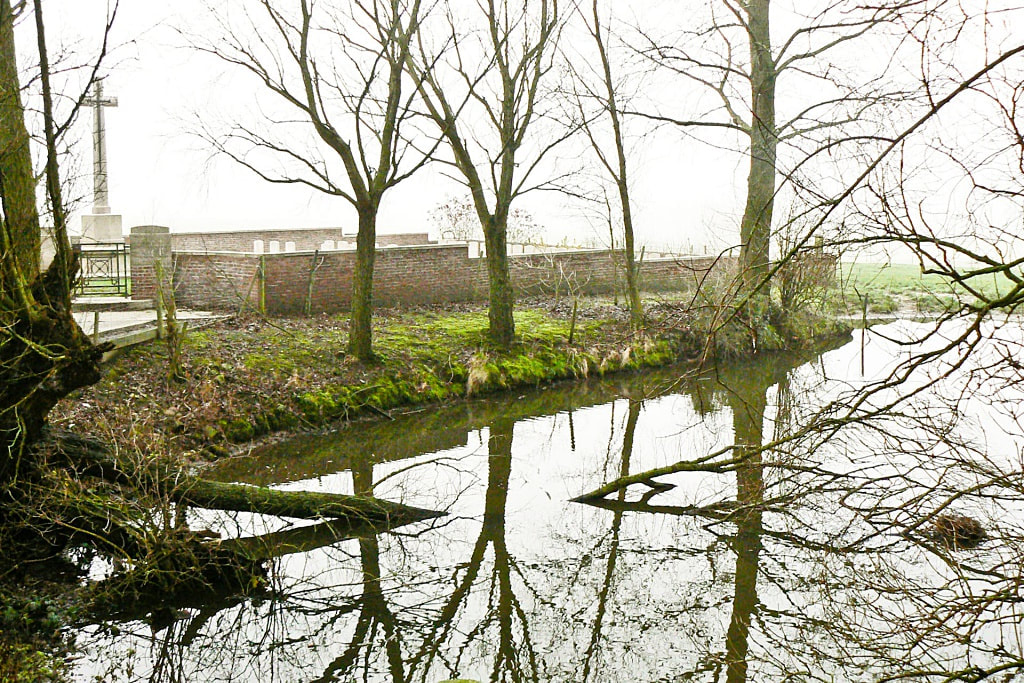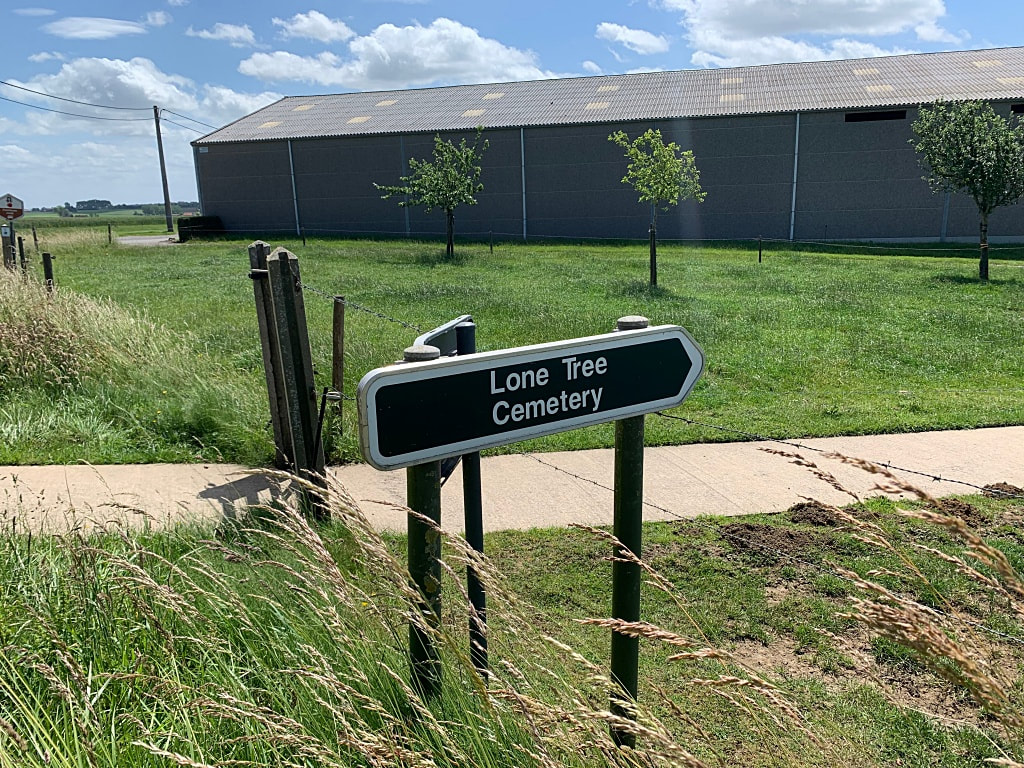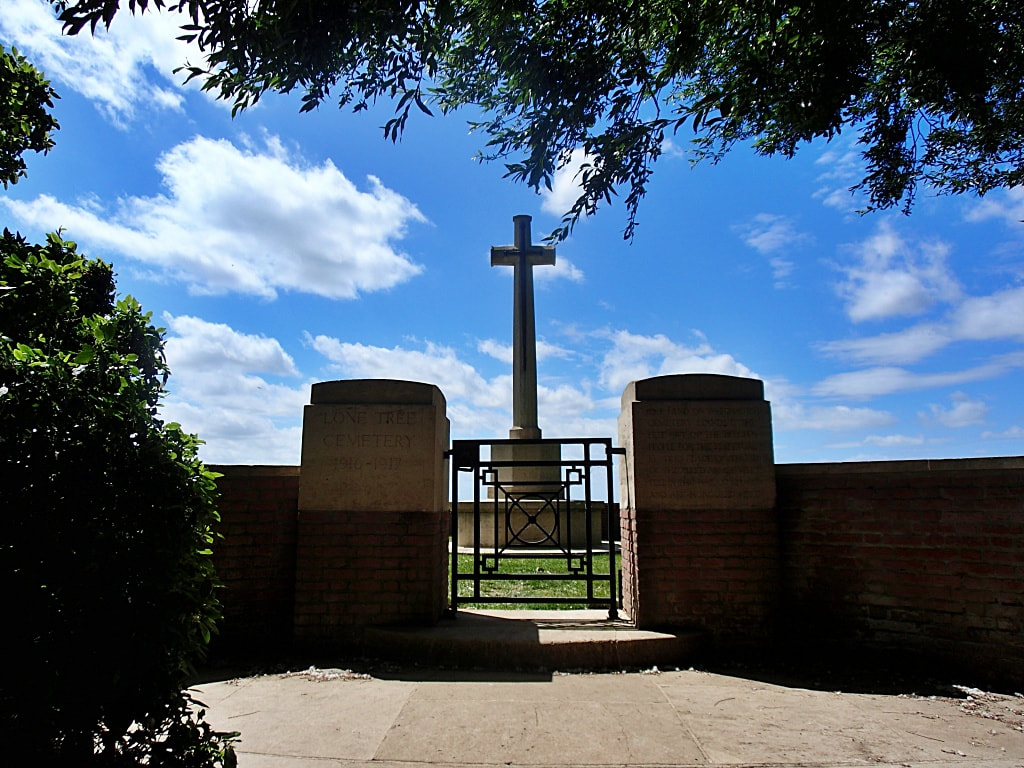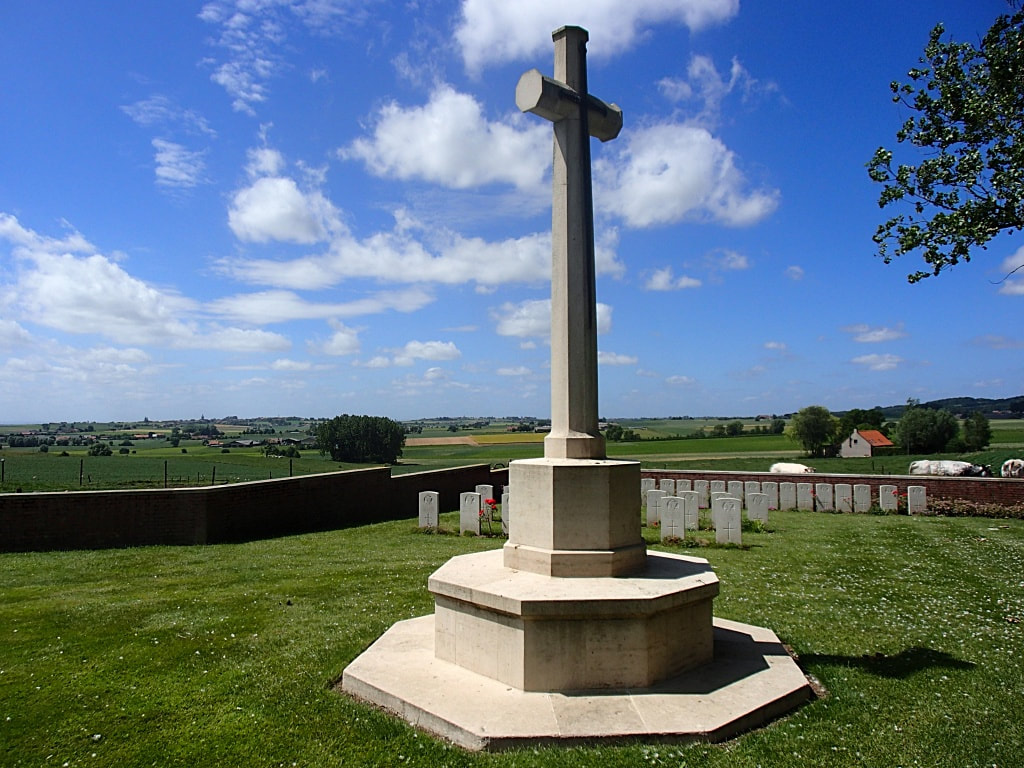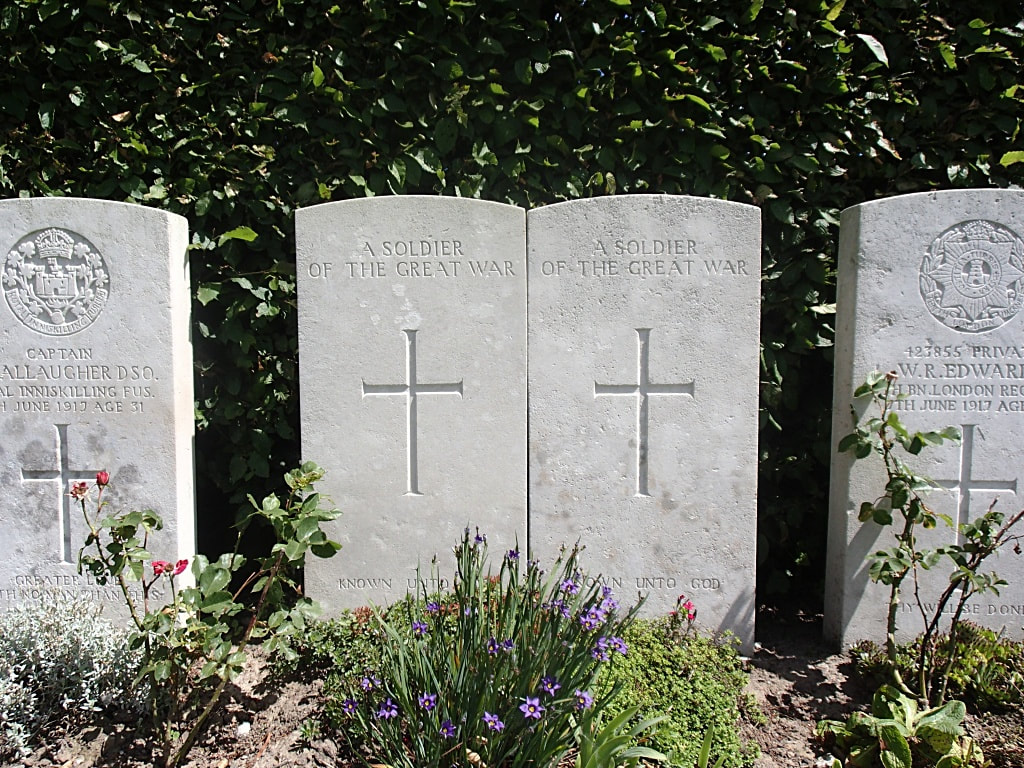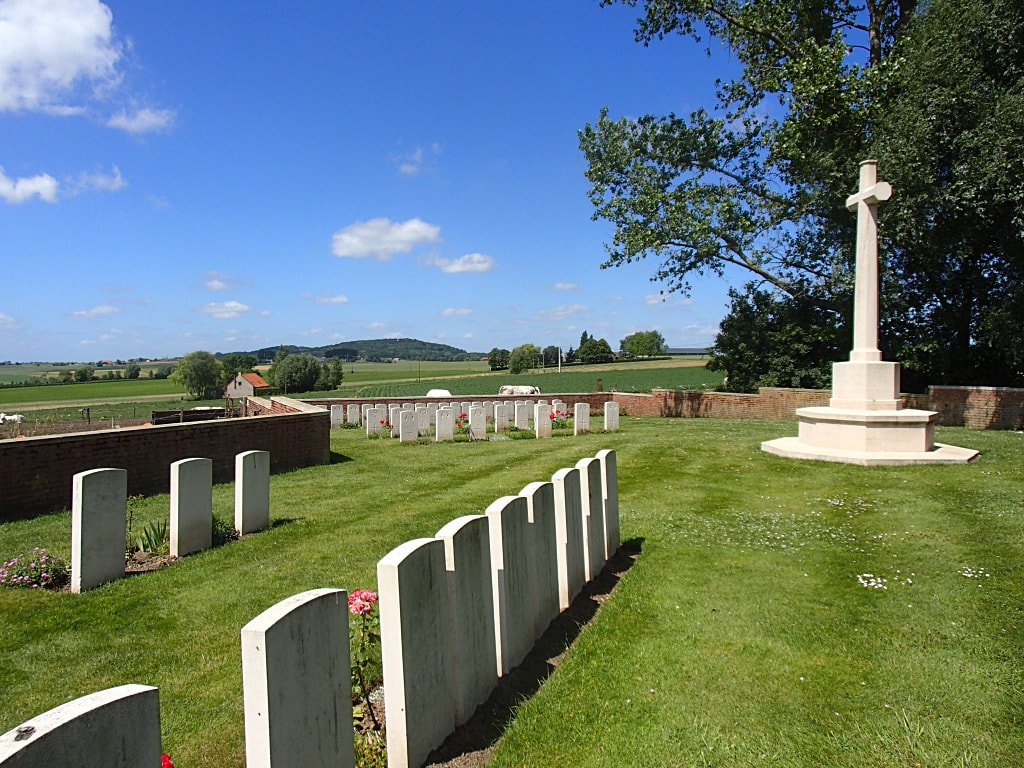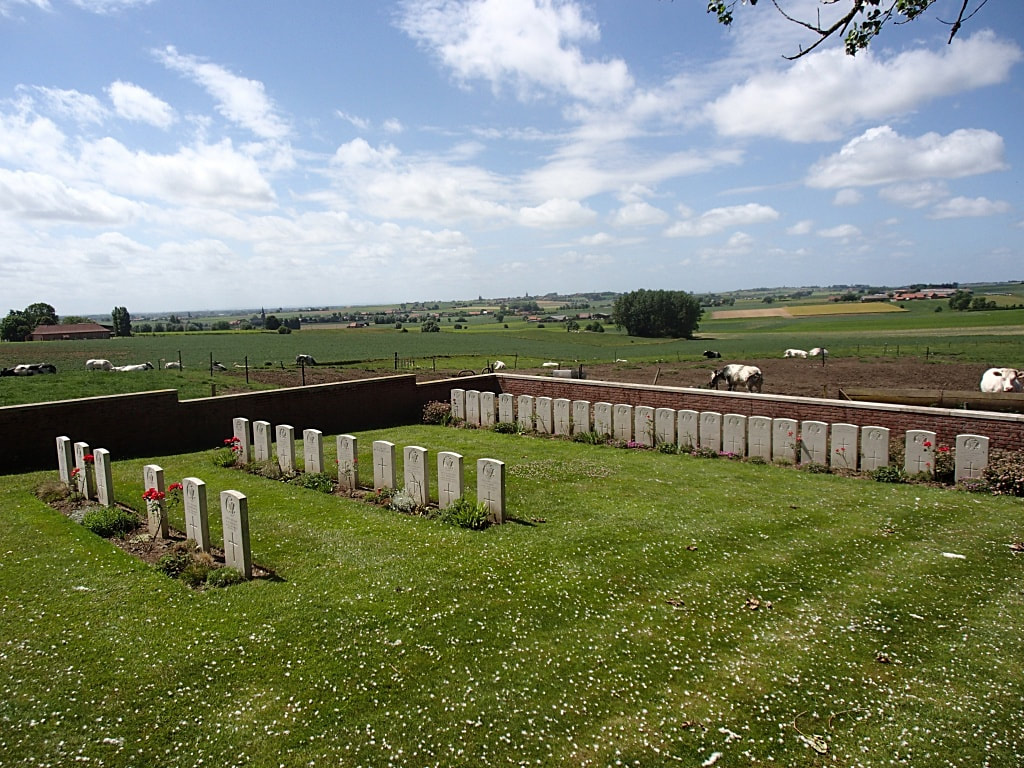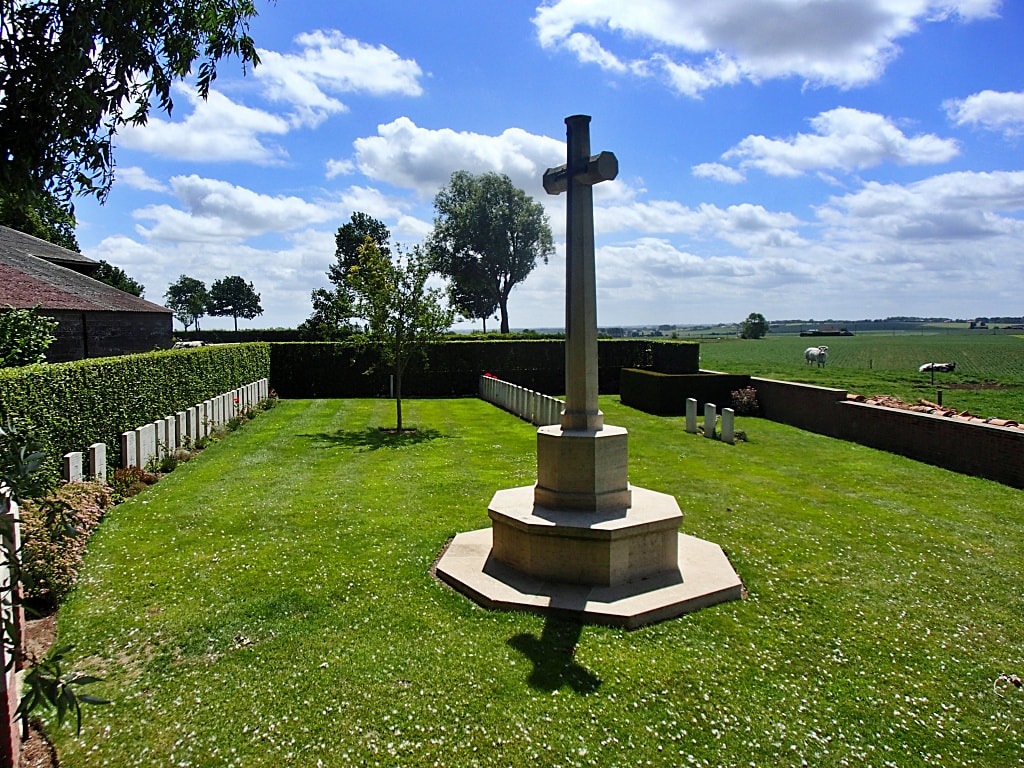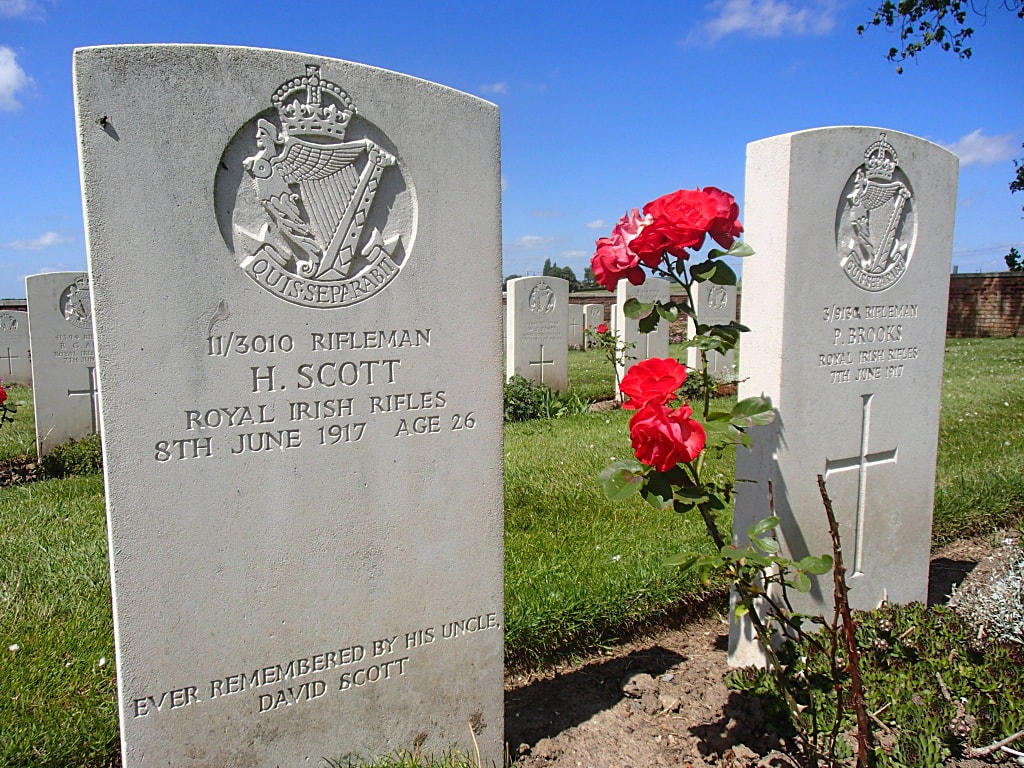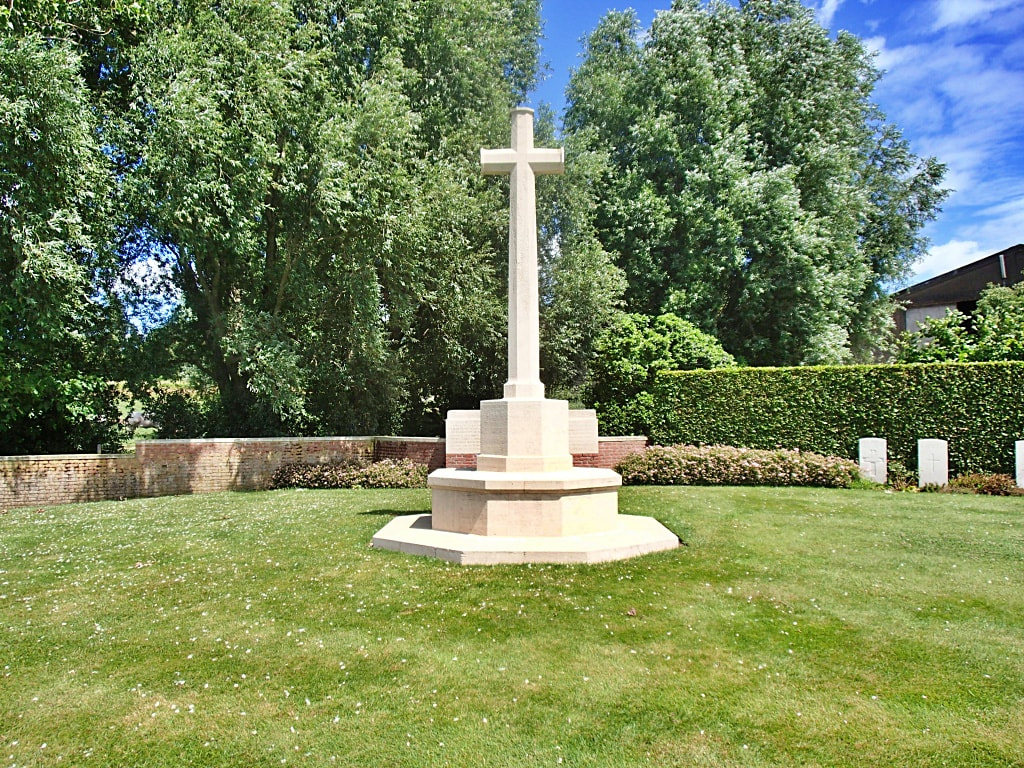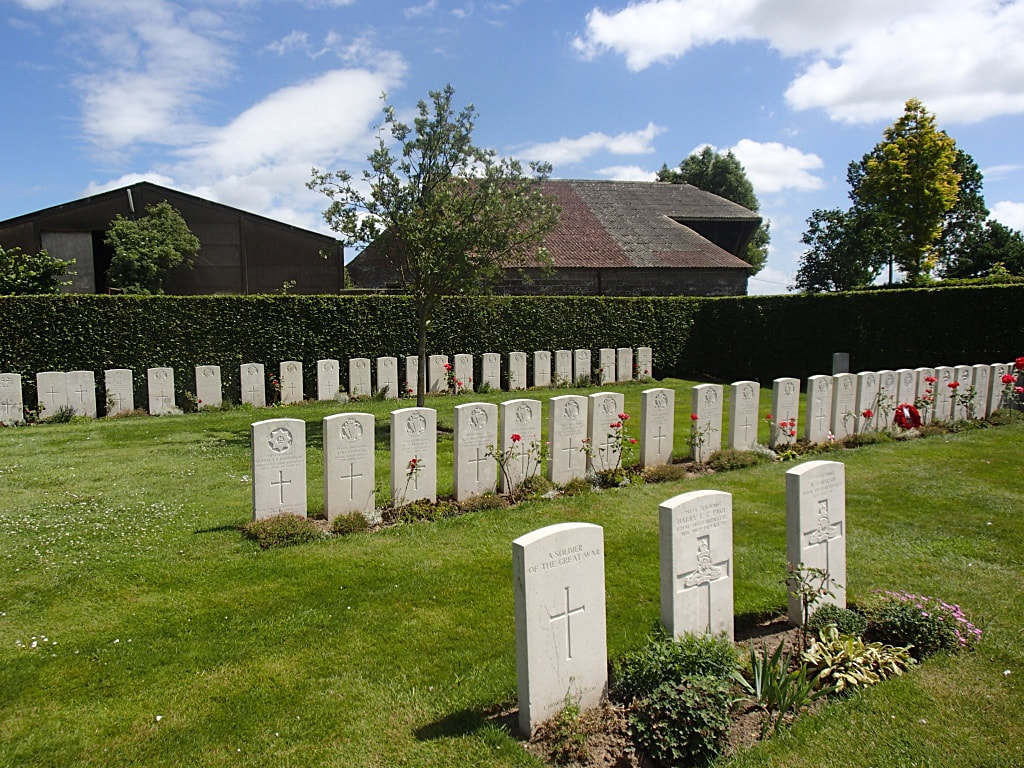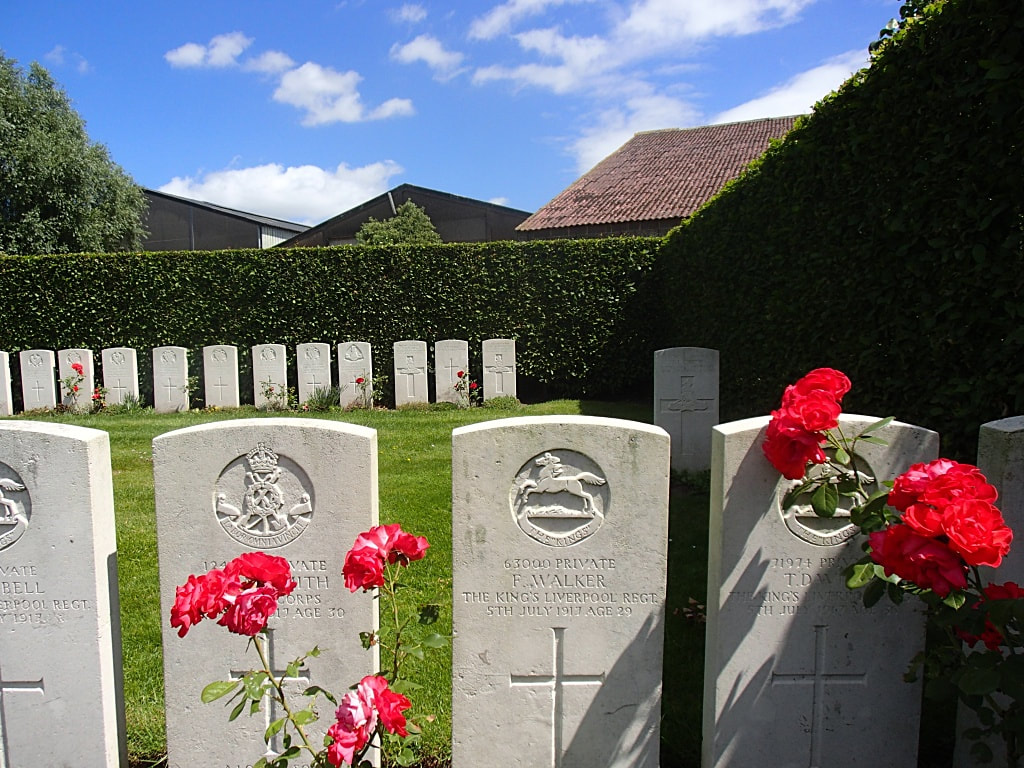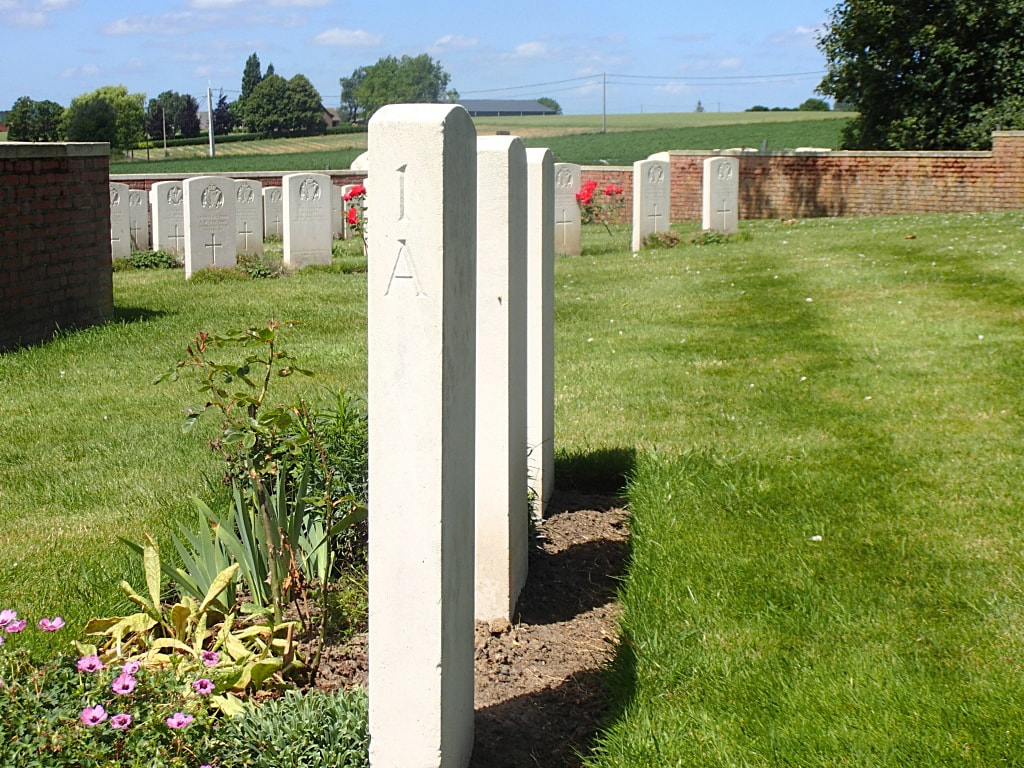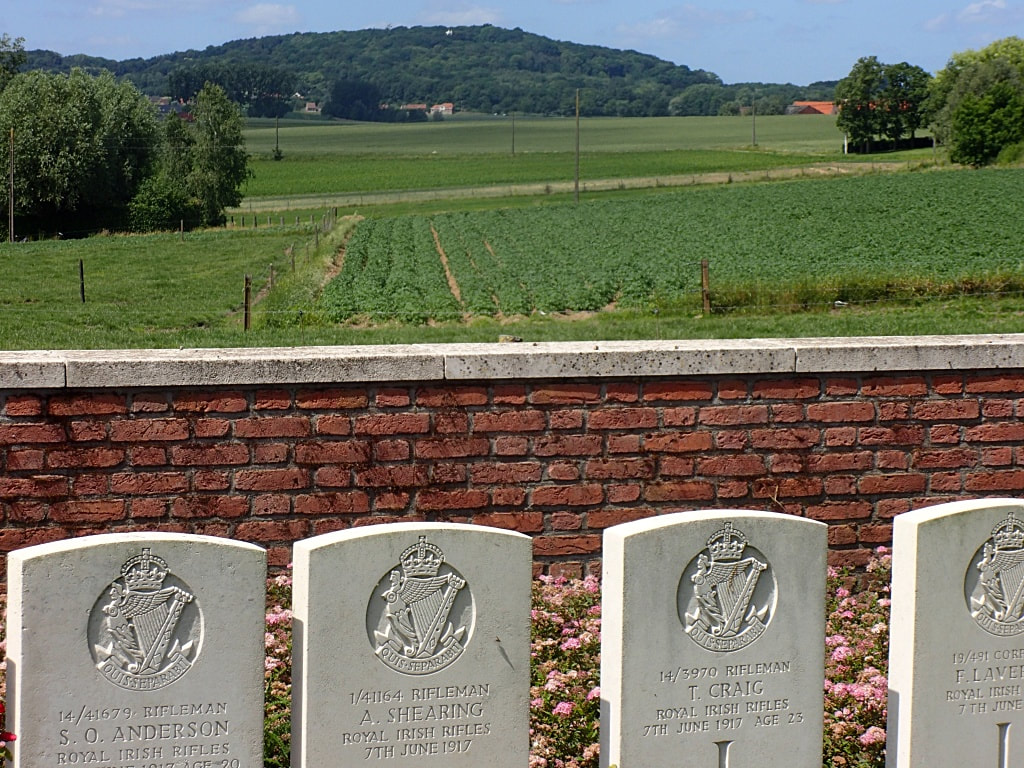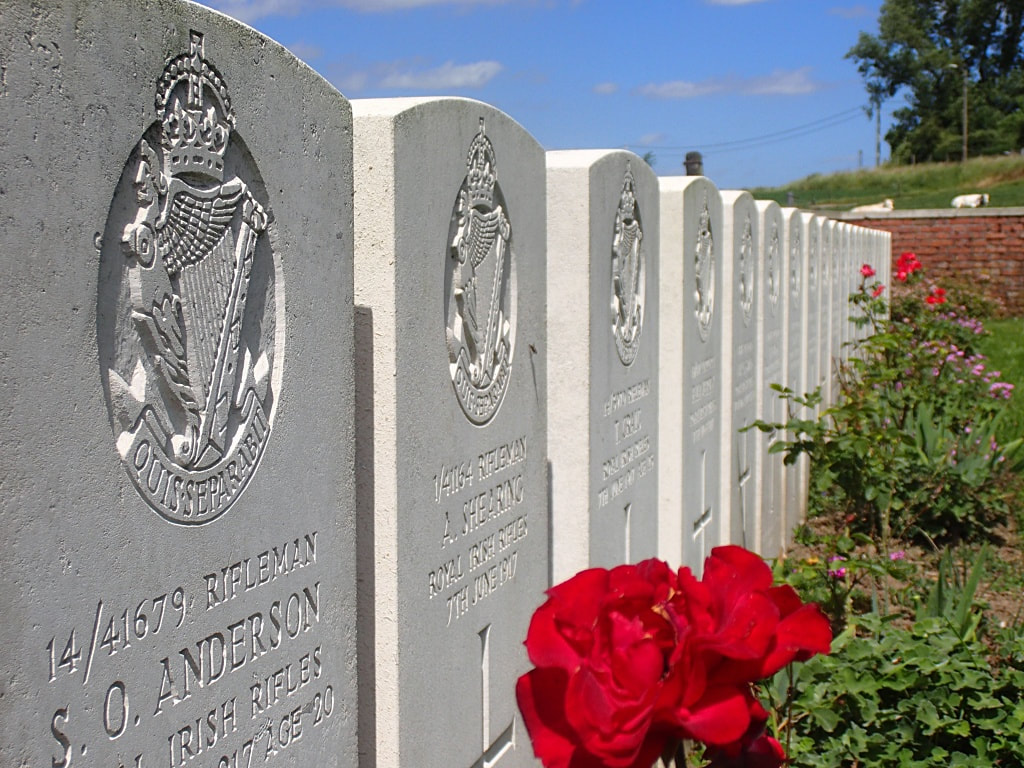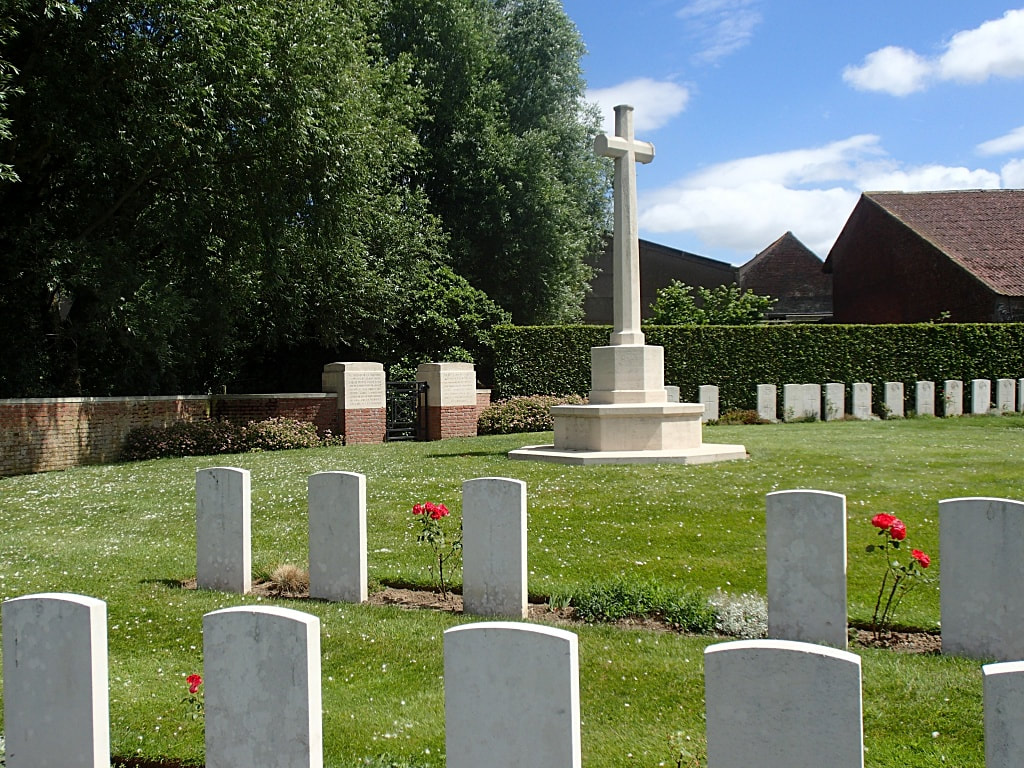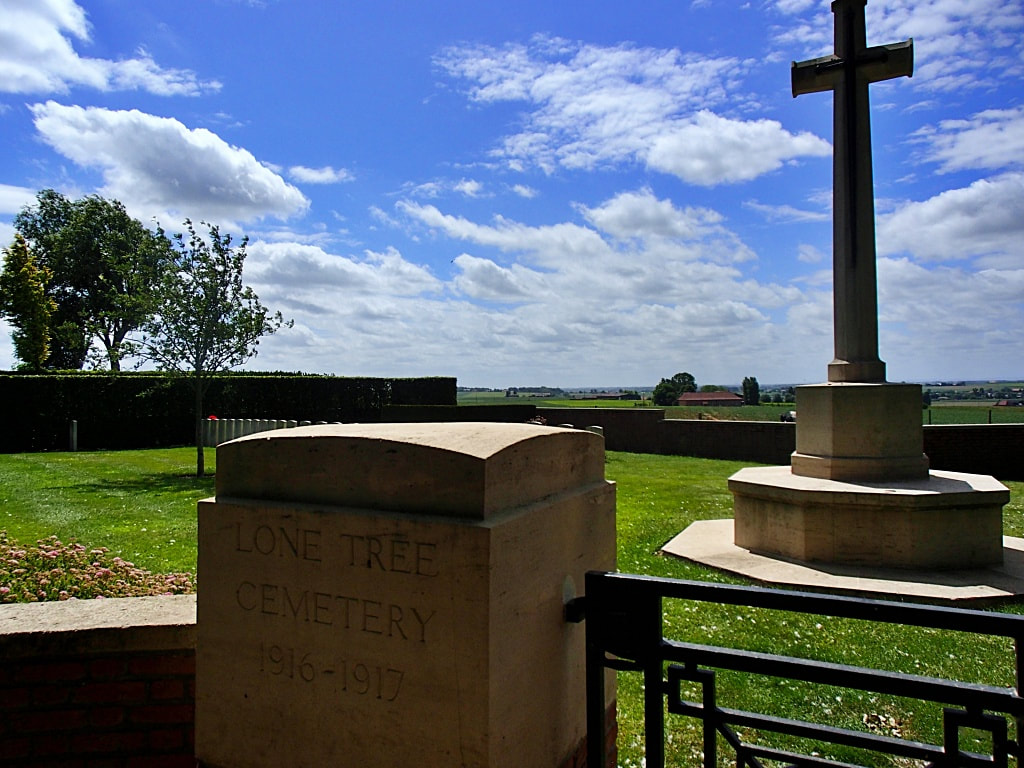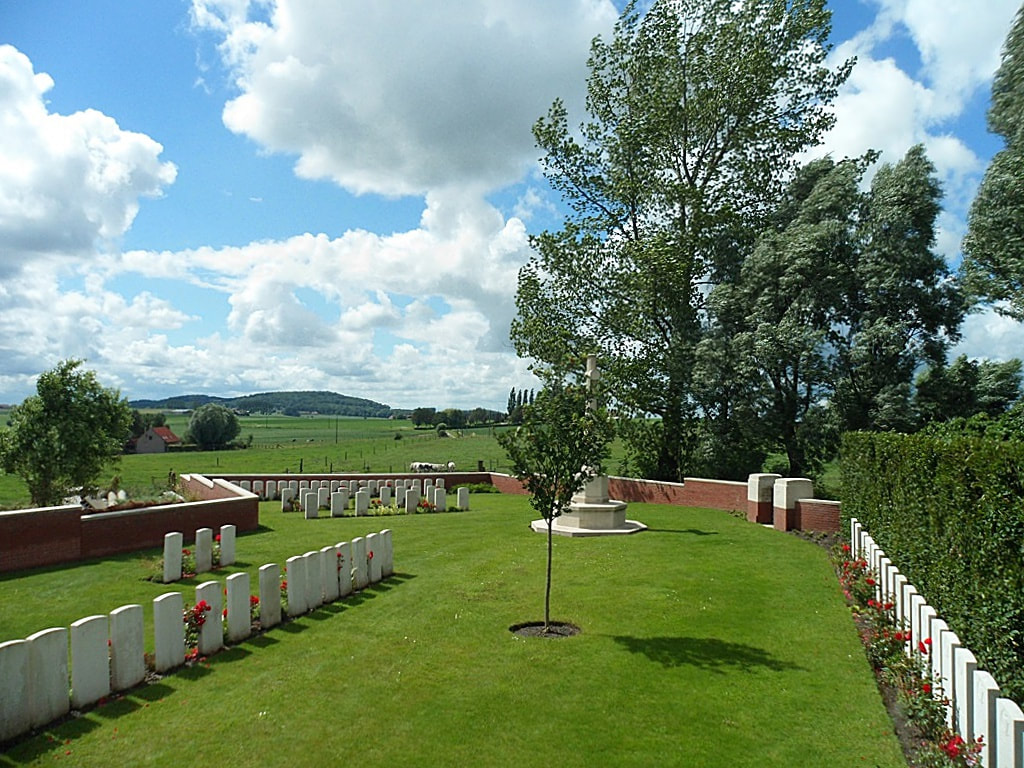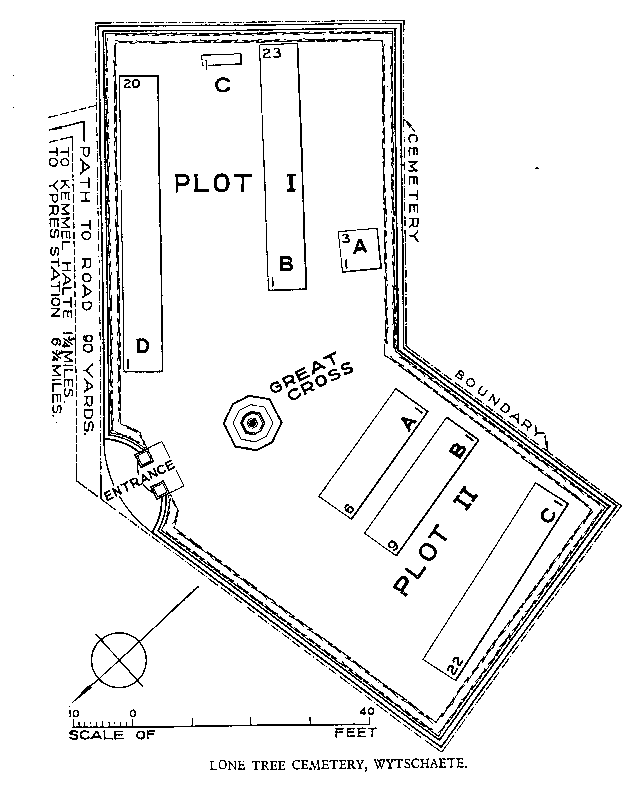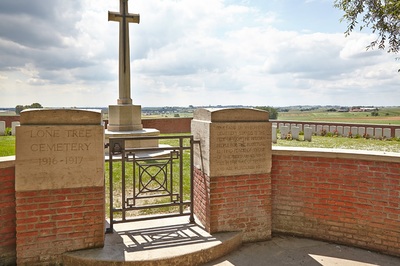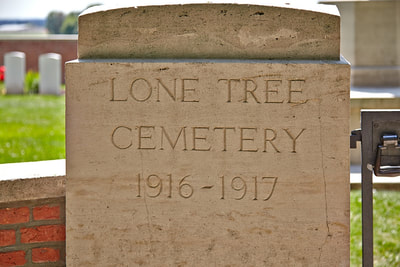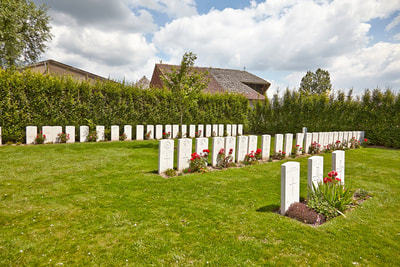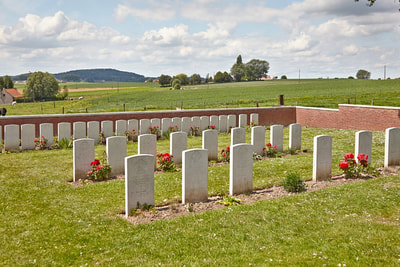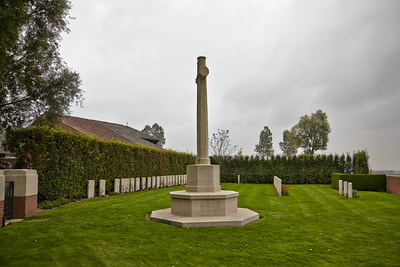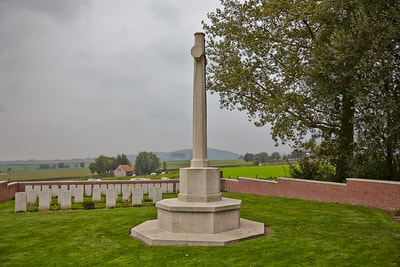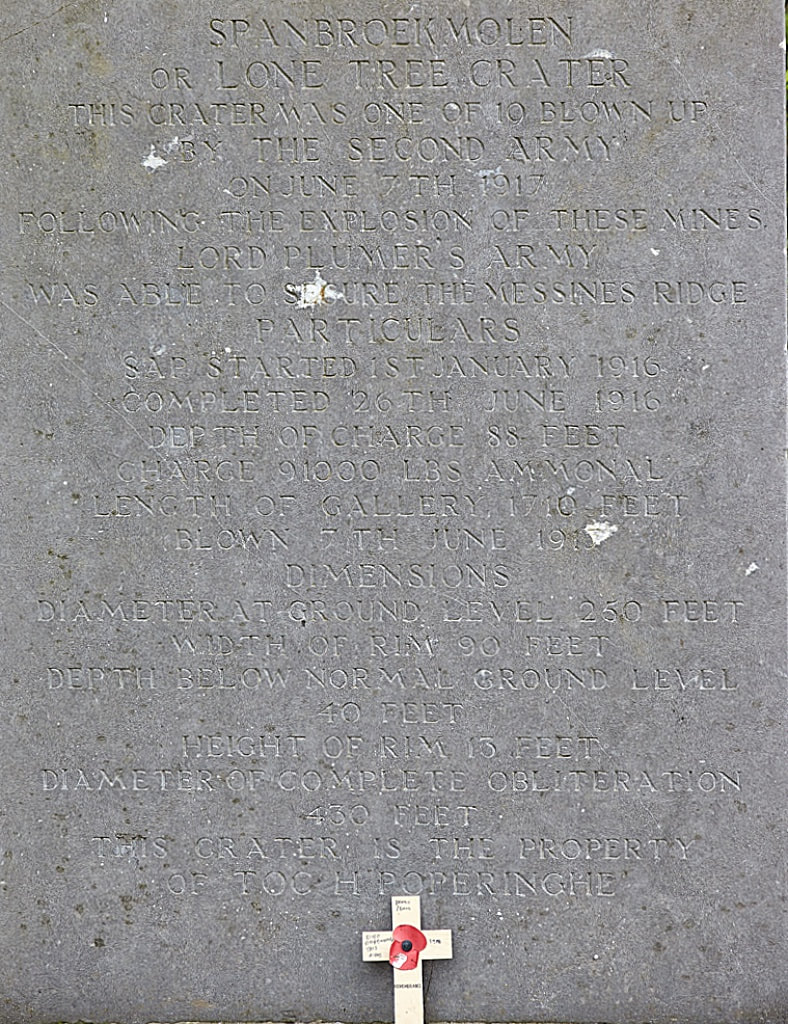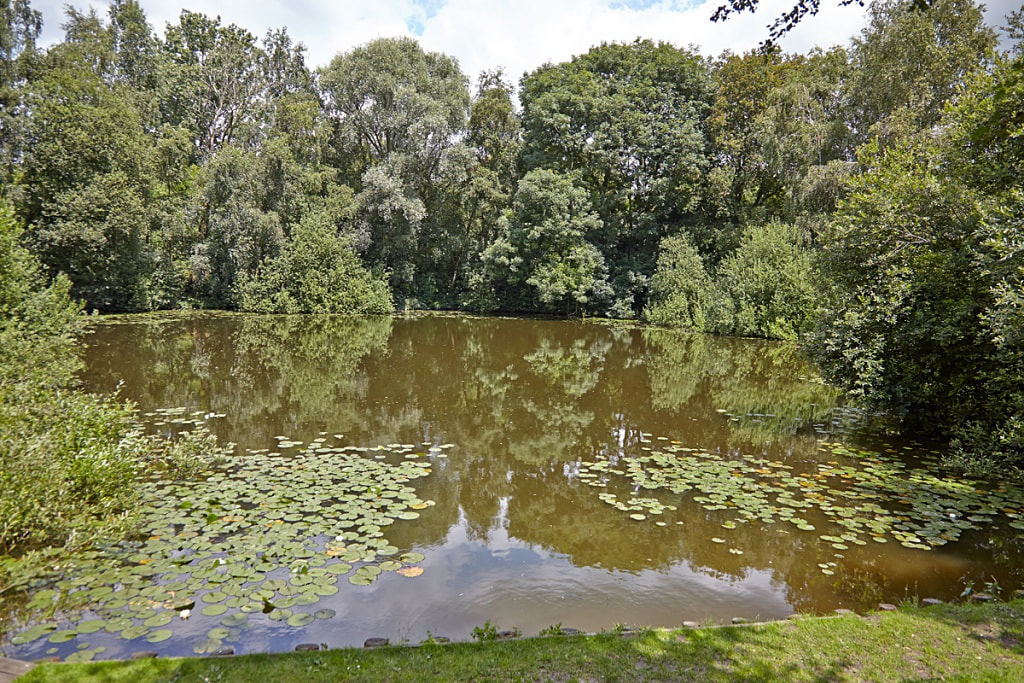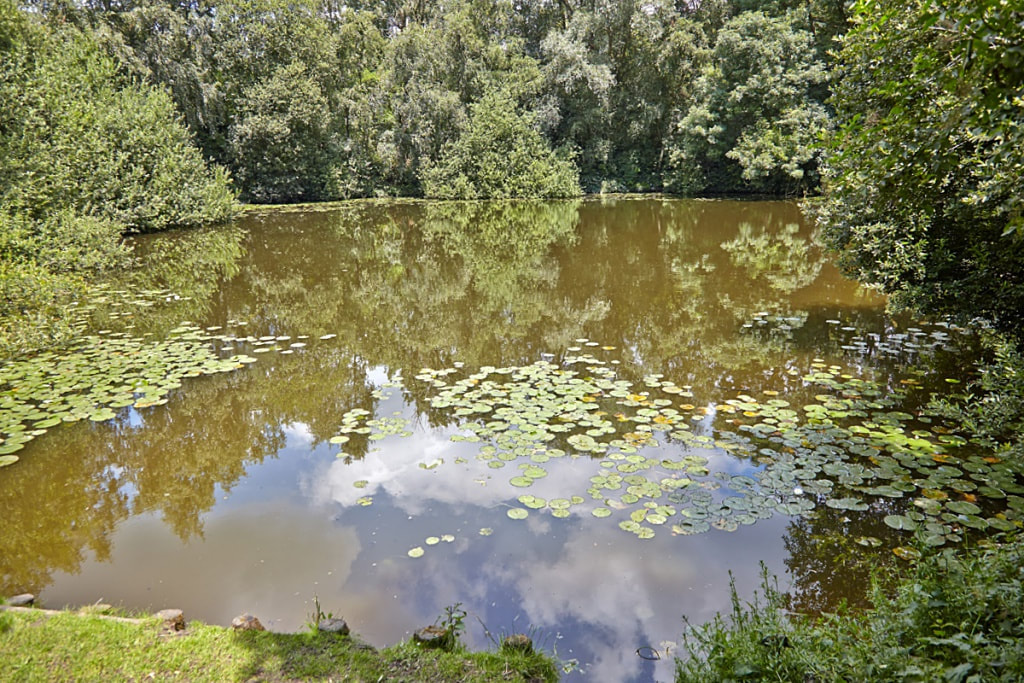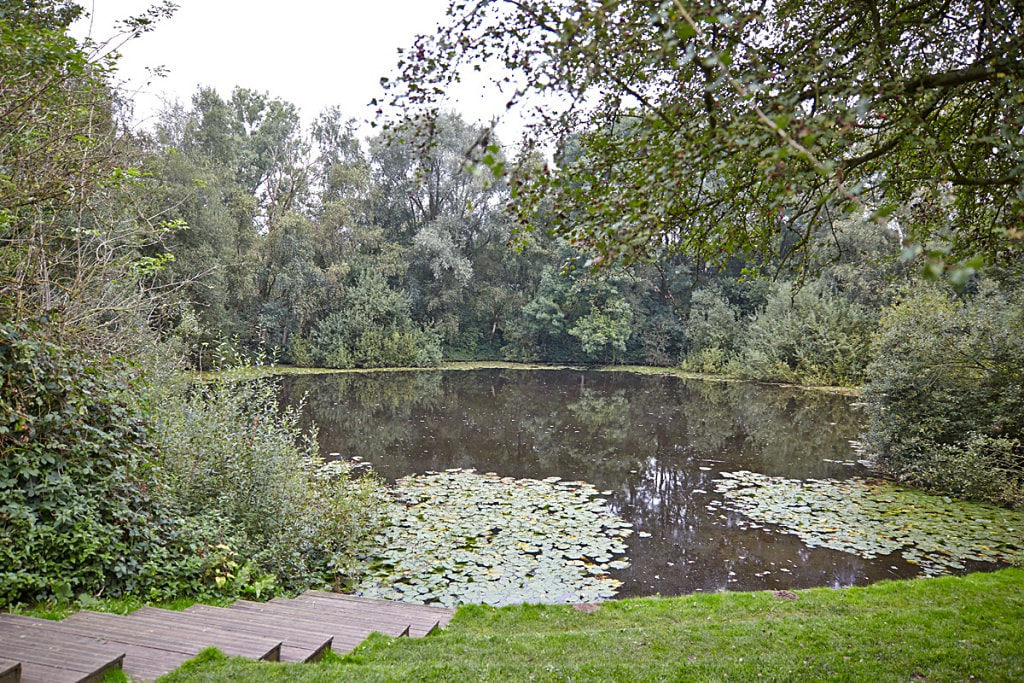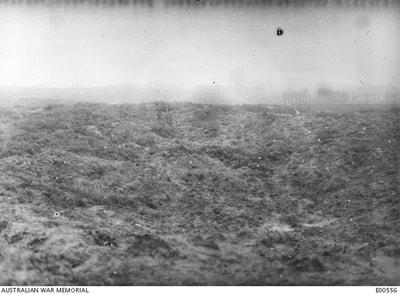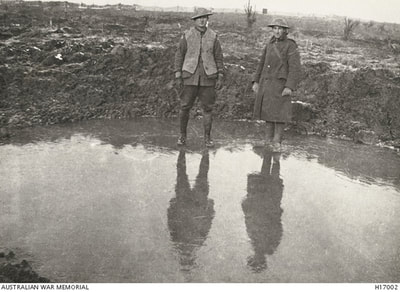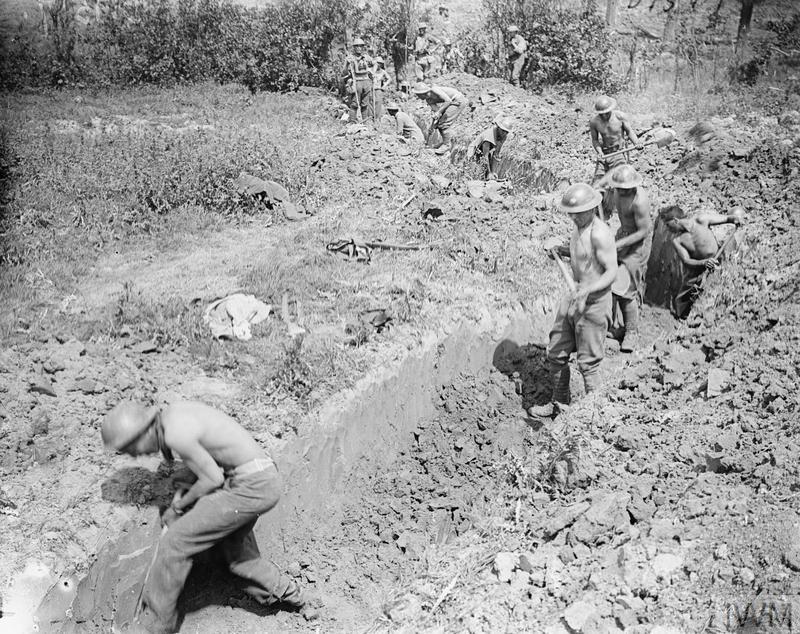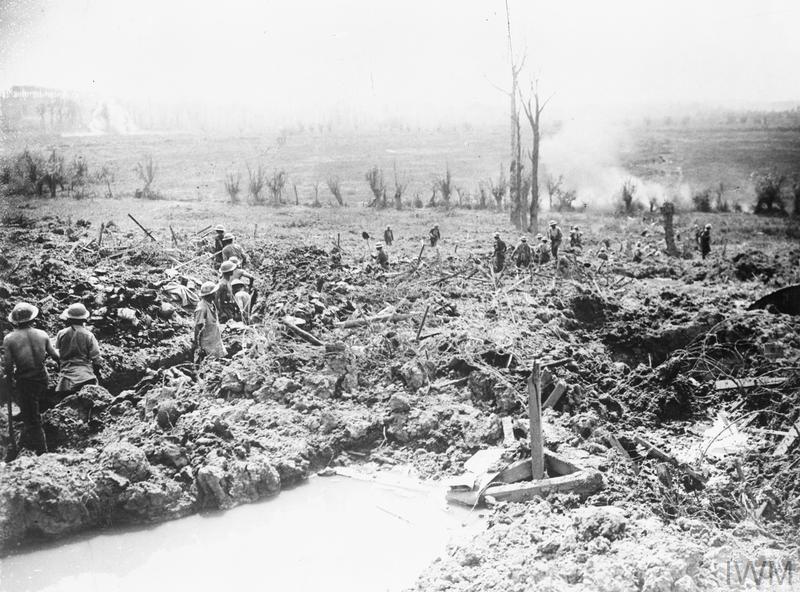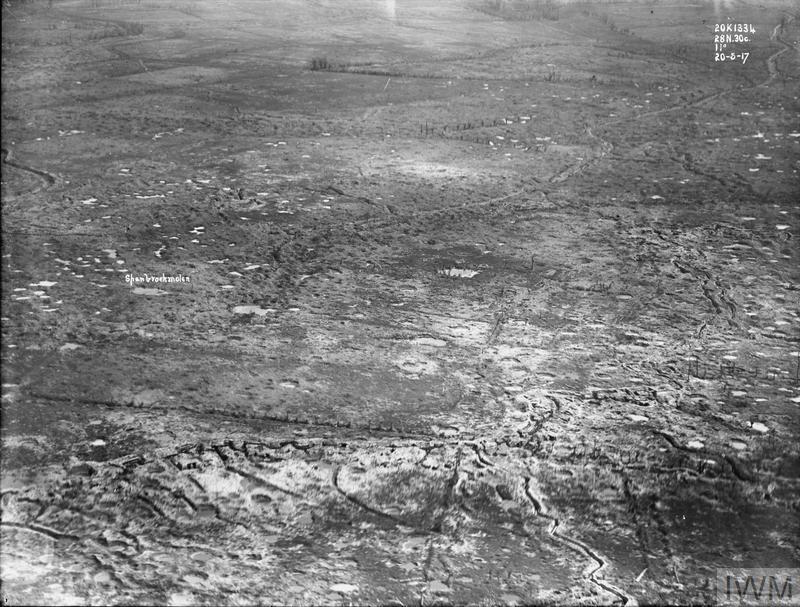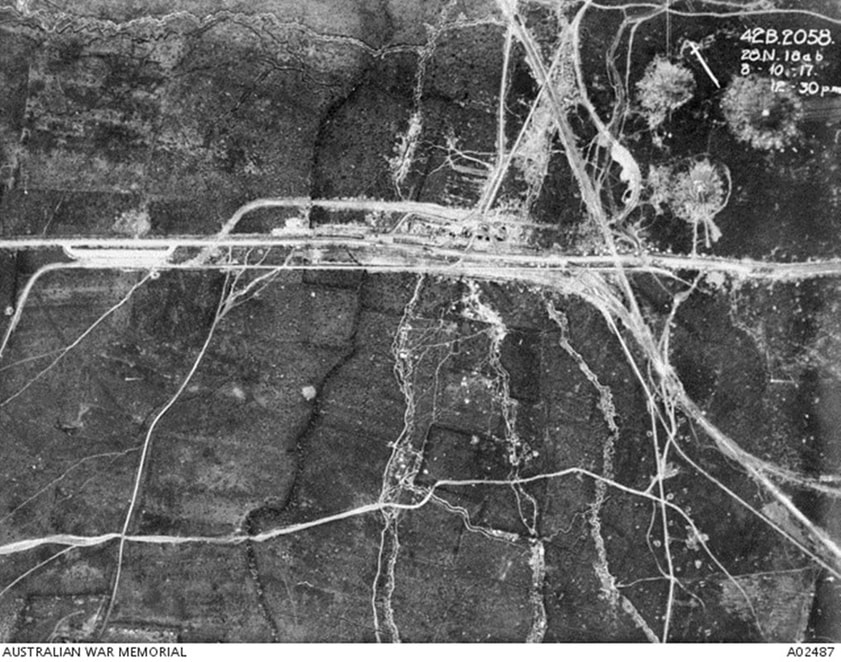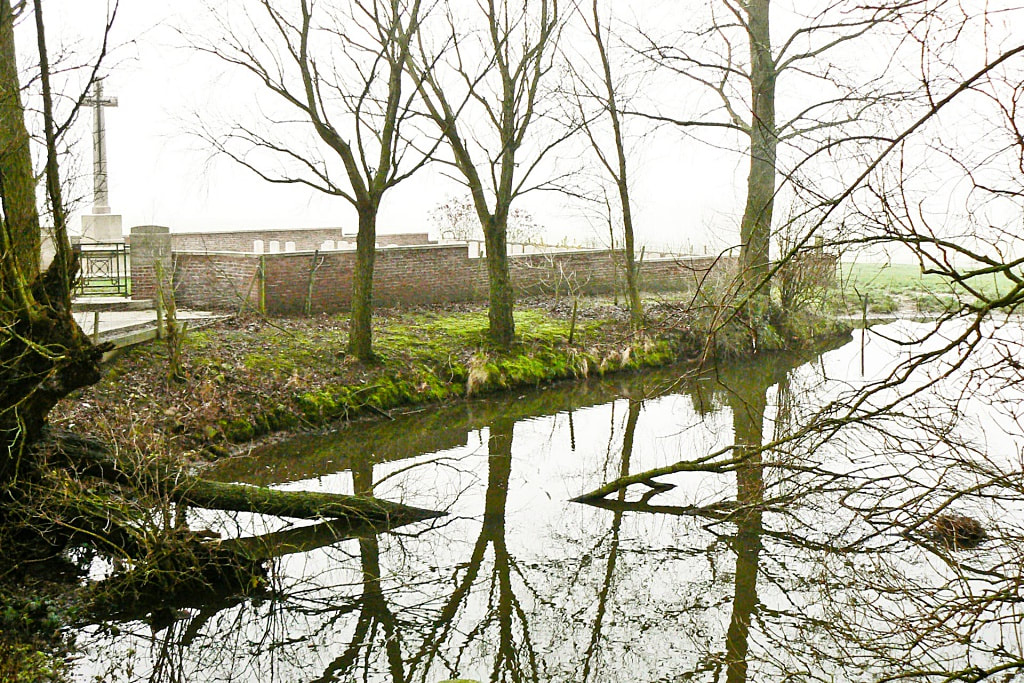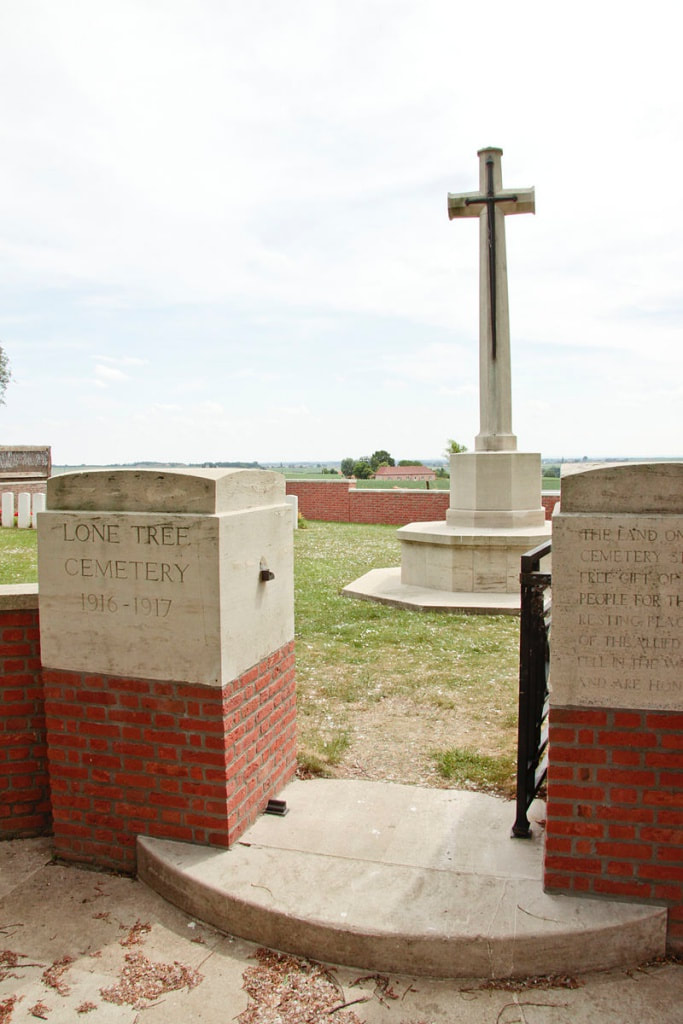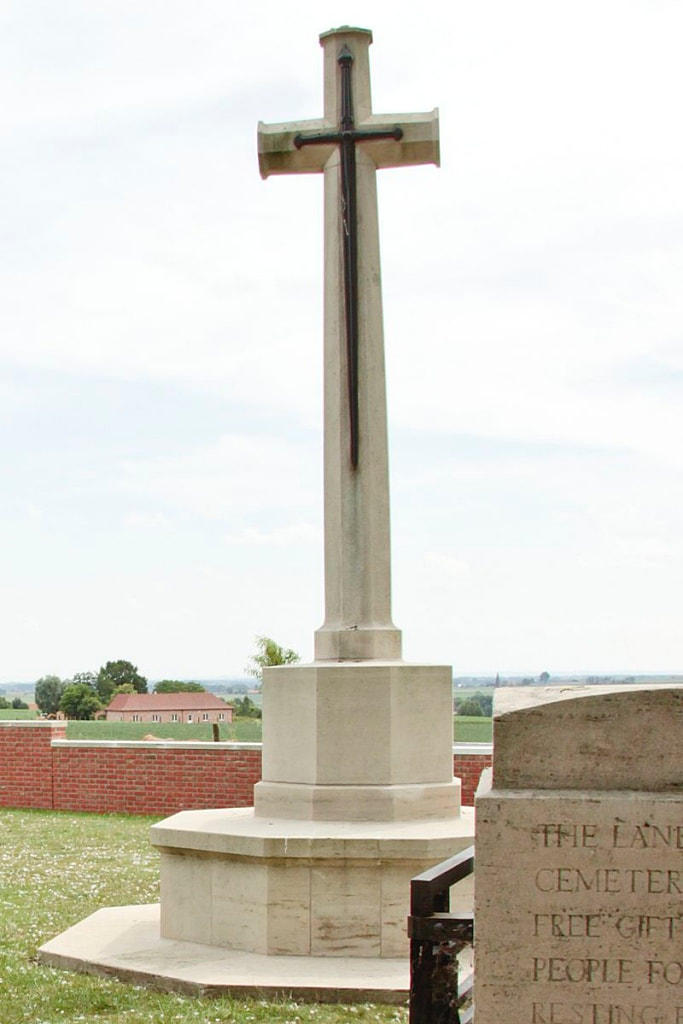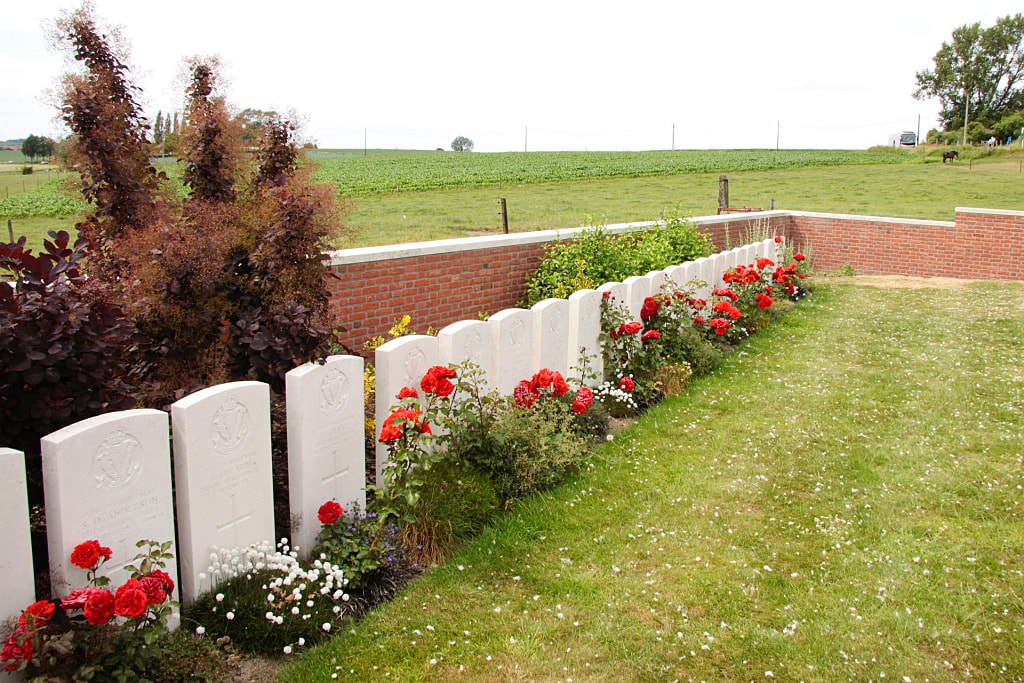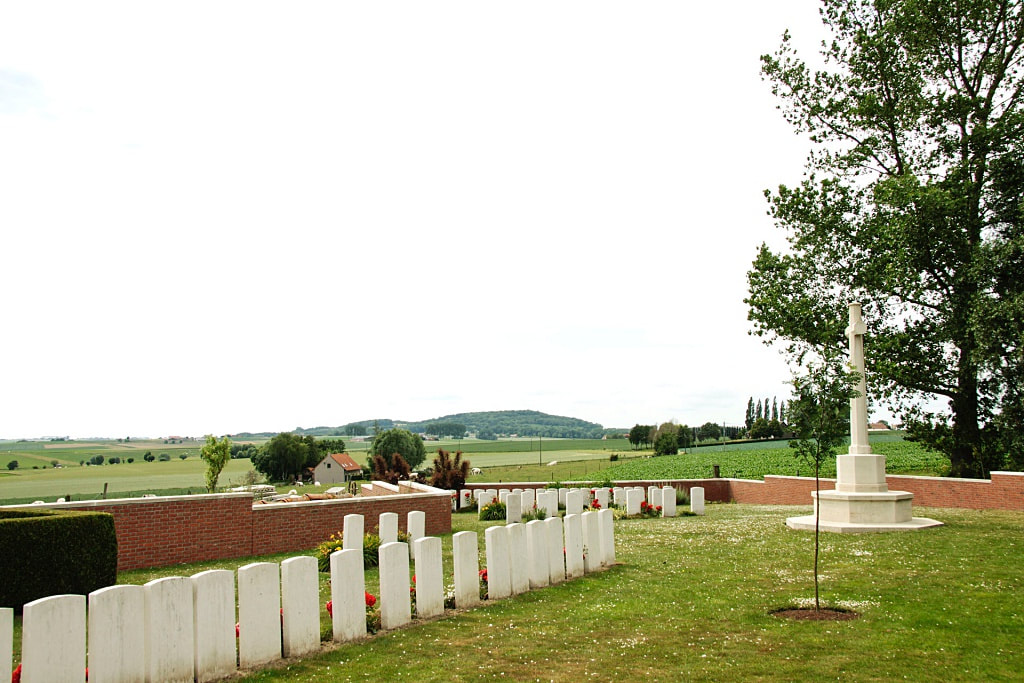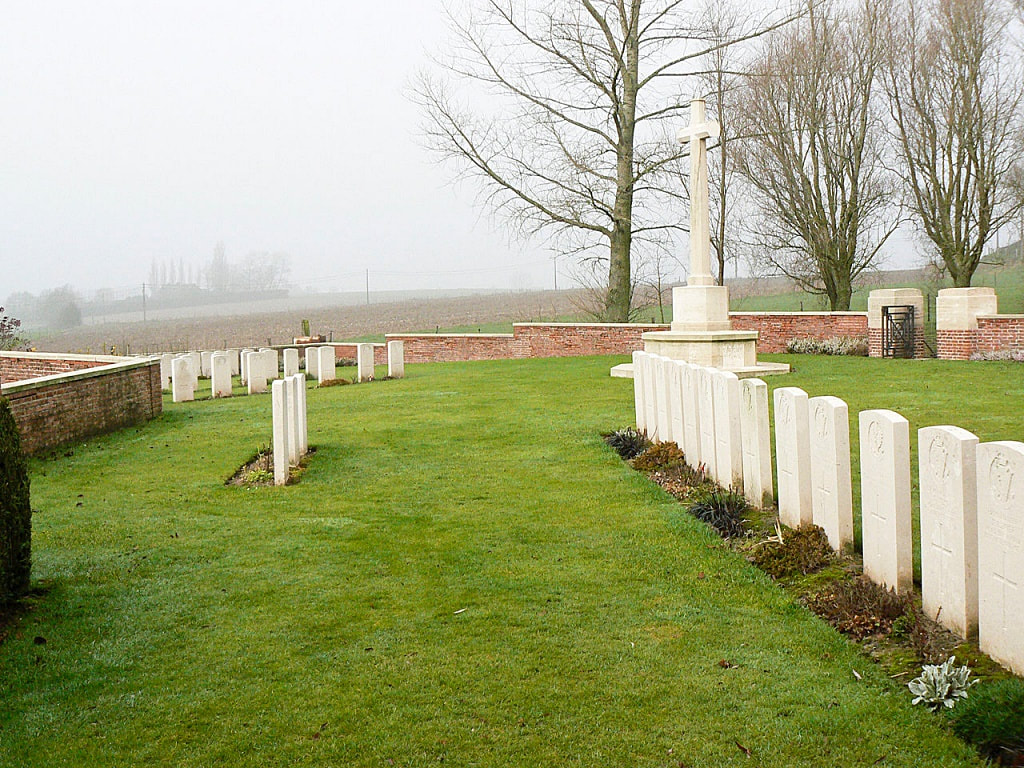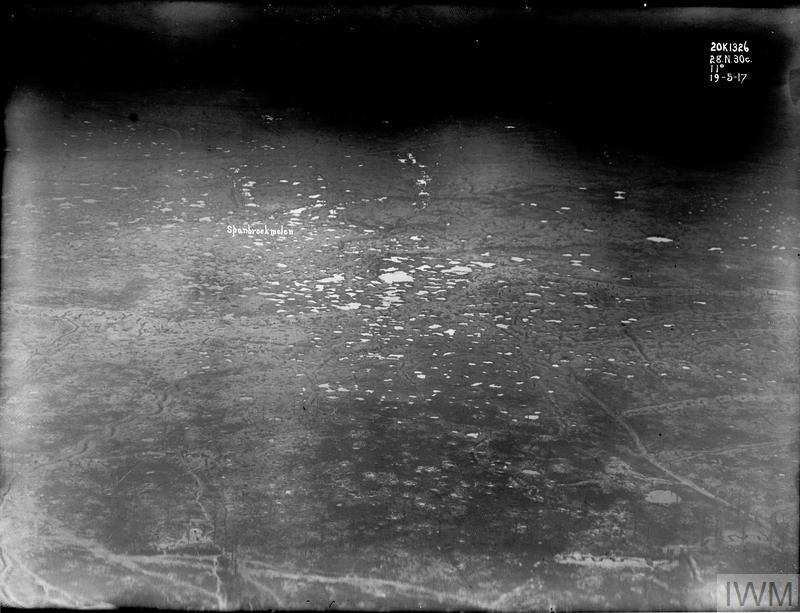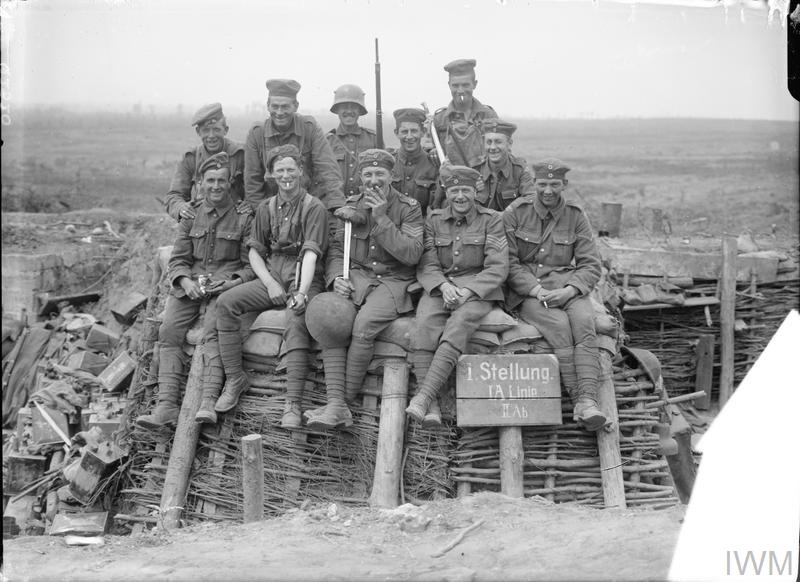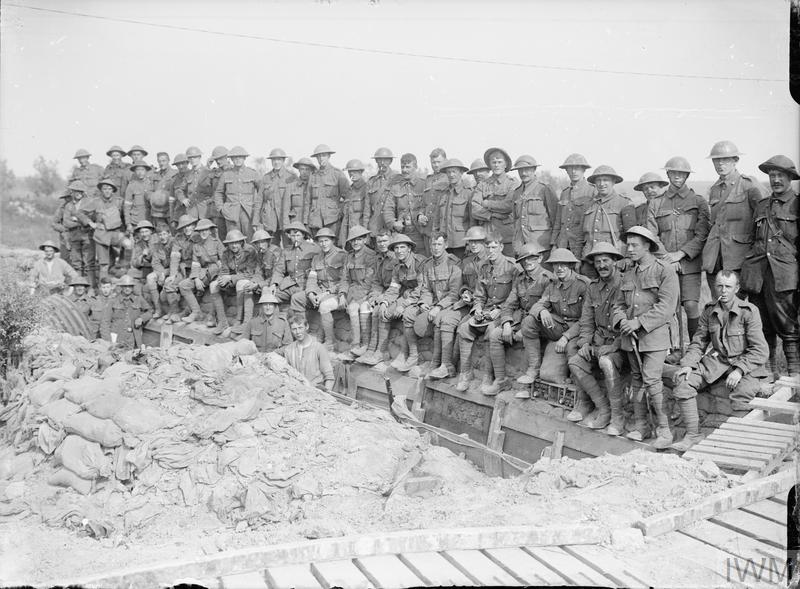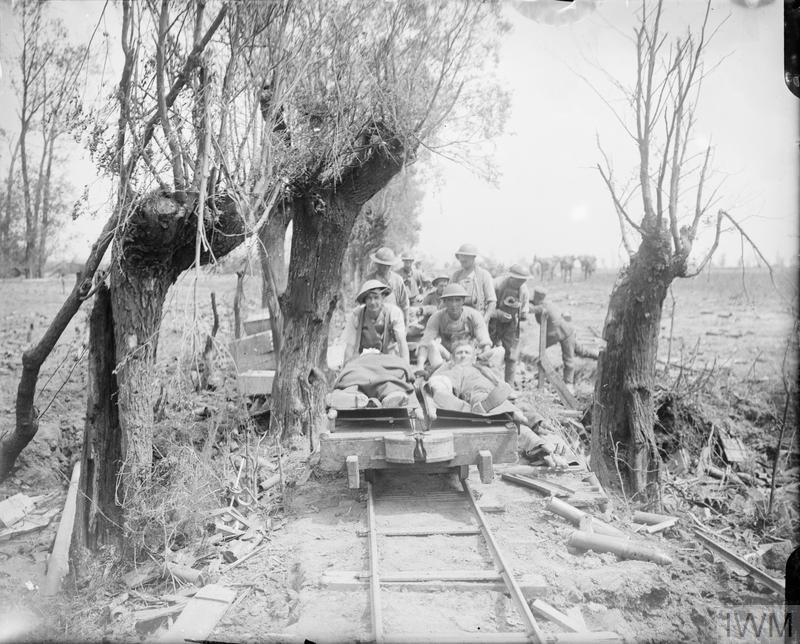LONE TREE CEMETERY
West-Vlaanderen
Belgium
GPS Coordinates: Latitude: 50.77468 Longitude: 2.86191
Location Information
Lone Tree Cemetery (Spanbroekmolen) is located 8.5 kilometres south of Ieper town centre, on a road leading from the Rijselseweg, N365, which connects Ieper to Wijtschate and on to Armentieres. From Ieper town centre the Rijselsestraat runs from the market square, through the Lille Gate (Rijselpoort) and directly over the crossroads with the Ieper ring road. The road name then changes to the Rijselseweg. On reaching the village of Wijtschate the first right hand turning leads onto Hospicestraat which leads onto the village square. Leave the village square following signs for Kemmel along Wijtschatestraat. After 2 kilometres turn left onto Kruisstraat. The cemetery lies 1 kilometre along the Kruisstraat on the right hand side of the road and is located at the rear of a farm.
Visiting Information
Visitors should note access to the cemetery is via a concrete path that crosses a field and then past a pond to the cemetery.
Wheelchair users should note that the path follows the contours of the ground and slopes down towards the cemetery, there is also a small step at the entrance to the cemetery.
Historical Information
Lone Tree Cemetery is close to the Lone Tree Crater, one of the nineteen which were made immediately before the infantry attack at the Battle of Messines in June 1917. Nearly all the graves in the cemetery are those of soldiers who fell on the first day of the battle.
Total Burials: 88.
Identified Casualties: United Kingdom 79.
Unidentified Casualties: United Kingdom 9.
The cemetery was designed by J R Truelove
Lone Tree Cemetery (Spanbroekmolen) is located 8.5 kilometres south of Ieper town centre, on a road leading from the Rijselseweg, N365, which connects Ieper to Wijtschate and on to Armentieres. From Ieper town centre the Rijselsestraat runs from the market square, through the Lille Gate (Rijselpoort) and directly over the crossroads with the Ieper ring road. The road name then changes to the Rijselseweg. On reaching the village of Wijtschate the first right hand turning leads onto Hospicestraat which leads onto the village square. Leave the village square following signs for Kemmel along Wijtschatestraat. After 2 kilometres turn left onto Kruisstraat. The cemetery lies 1 kilometre along the Kruisstraat on the right hand side of the road and is located at the rear of a farm.
Visiting Information
Visitors should note access to the cemetery is via a concrete path that crosses a field and then past a pond to the cemetery.
Wheelchair users should note that the path follows the contours of the ground and slopes down towards the cemetery, there is also a small step at the entrance to the cemetery.
Historical Information
Lone Tree Cemetery is close to the Lone Tree Crater, one of the nineteen which were made immediately before the infantry attack at the Battle of Messines in June 1917. Nearly all the graves in the cemetery are those of soldiers who fell on the first day of the battle.
Total Burials: 88.
Identified Casualties: United Kingdom 79.
Unidentified Casualties: United Kingdom 9.
The cemetery was designed by J R Truelove
Images in this gallery © Geerhard Joos
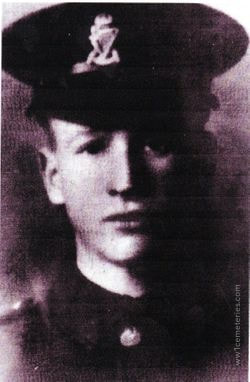
3/9065 Lance Corporal
Thomas Newcomen Corry Burnett
8th Bn. Royal Irish Rifles
7th June 1917, aged 20.
Plot II. C. 18.
Son of Samuel and Catherine Burnett, of Abbeydug, Kenagh, Co. Longford.
Thomas Newcomen Corry Burnett
8th Bn. Royal Irish Rifles
7th June 1917, aged 20.
Plot II. C. 18.
Son of Samuel and Catherine Burnett, of Abbeydug, Kenagh, Co. Longford.
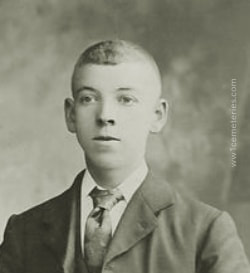
18/960 Rifleman
James Greet
12th Bn. Royal Irish Rifles
7th June 1917, aged 19.
Plot II. B. 4.
Son of James and Elizabeth Greer, of 206, Blythe St., Belfast.
His headstone bears the inscription "In The Midst Of Life We Are In Death"
James Greet
12th Bn. Royal Irish Rifles
7th June 1917, aged 19.
Plot II. B. 4.
Son of James and Elizabeth Greer, of 206, Blythe St., Belfast.
His headstone bears the inscription "In The Midst Of Life We Are In Death"
The Spanbroekmolen or Lone Tree Crater
A major attack on Spanbroekmolen and the neighbouring strongpoints Peckham and Kruisstraat was planned by the British for the Battle of Messines. It was known that, due to its importance, the Germans intended to hold the hill at Spanbroekmolen at all costs (unbedingtes Halten). In order to break the heavily armed positions, the British employed tunnelling companies of the Royal Engineers with the aim of placing a series of mines beneath the German lines on the Messines Ridge. The start point for the Spanbroekmolen mine gallery was in the area of a small wood some 270 metres (300 yd) to the south-west of the hamlet. In December 1915, 250th Tunnelling Company dug a 18 metres (60 ft) shaft and then handed over the work to 3rd Canadian Tunnelling Company in January 1916. Other operating changes – including a brief tenure of 175th Tunnelling Company at Spanbroekmolen in April 1916 – occurred until 171st Tunnelling Company took over and extended the work to the German lines, driving the tunnel forward for seven months until it was beneath the powerful German position. The mine chamber was set 27 metres (88 ft) below ground, at the end of a gallery 521 metres (1,709 ft) long. At the end of June 1916 the charge of 41,000 kilograms (91,000 lb) of ammonal in 1,820 waterproof tins was complete, the largest yet laid by the British. With the mine complete, the British selected two additional objectives to be attacked near Spanbroekmolen, Rag Point and Hop Point, which were 820 metres (2,700 ft) and 1,100 metres (3,500 ft) from the main tunnel. A branch was started and inclined down to 37 metres (120 ft) depth. By mid-February 1917 the branch had been driven 350 metres (1,140 ft) and passed the German lines. At that point, the German counter mining activities damaged 150 metres (500 ft) of the branch gallery and some of the main tunnel. The British decided to abandon the branch gallery because aggressive counter-mining would likely have alerted the Germans to the presence of a deep-mining scheme. On 3 March 1917, the Germans blew the main tunnel with a heavy charge laid from their Ewald shaft, leaving it beyond repair and resulting the 41,000-kilogram (91,000 lb) explosive charge being cut off for three months. The British started a new gallery alongside the old main tunnel which after 357 metres (1,172 ft) cut into the original workings. Mining was greatly hampered by the influx of gas, several miners being overcome by the fumes, but eventually – and only a few hours before Zero Hour – the main charge was ready again and secured by 120 metres (400 ft) of tamping with sandbags and a primer charge of 450 kilograms (1,000 lb) of dynamite. Although tested fully just a few hours before the attack, officers used torch batteries to prove the circuits.The mines at Messines were detonated at 03:10 a.m. on 7 June 1917. The Spanbroekmolen mine exploded 15 seconds late, by which time soldiers of the 36th (Ulster) Division had already left their trenches and begun to move across no-man's land. In addition to obliterating the German fortifications, falling debris from the blast also killed a number of British soldiers, some of whom are buried at Lone Tree Cemetery. The crater formed by the blast was approximately 76 metres (250 ft) in diameter, and 12 metres (40 ft) deep.
Pictures in this gallery © Werner Van Caneghem
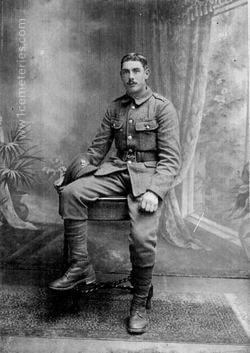
43020 Private
Harry House
11th Bn. Royal Inniskilling Fusiliers
7th June 1917, aged 21.
Plot II. B. 1.
Son of William and Annie House, of Syerston, Newark, Notts.
Harry House
11th Bn. Royal Inniskilling Fusiliers
7th June 1917, aged 21.
Plot II. B. 1.
Son of William and Annie House, of Syerston, Newark, Notts.
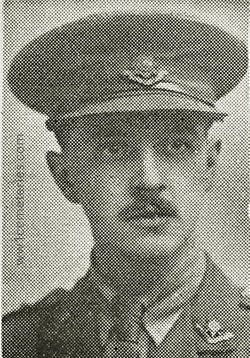
Lieutenant
Alban John Benedict Hudson, M. C.
"B" Company, Worcester Regiment
7th June 1917, aged 23.
Plot I. B. 1.
Born at Oxford. Son of the Rev. and Mrs. C. H. Bickerton Hudson, of Holy Rood, St. Giles', Oxford, and of Wyke Manor, Pershore, Worcs. Commoner of Magdalen College, Oxford. Formerly with 11th Bn. in France and Salonika.
His headstone bears the inscription "Jesu, For Thy Bitter Passion His Soul To Thy Salvation"
Alban John Benedict Hudson, M. C.
"B" Company, Worcester Regiment
7th June 1917, aged 23.
Plot I. B. 1.
Born at Oxford. Son of the Rev. and Mrs. C. H. Bickerton Hudson, of Holy Rood, St. Giles', Oxford, and of Wyke Manor, Pershore, Worcs. Commoner of Magdalen College, Oxford. Formerly with 11th Bn. in France and Salonika.
His headstone bears the inscription "Jesu, For Thy Bitter Passion His Soul To Thy Salvation"

